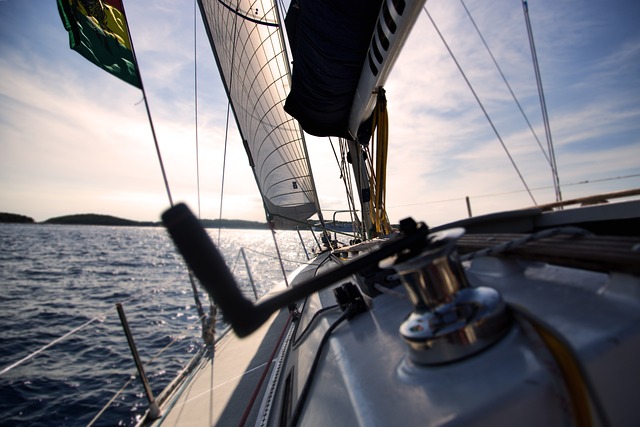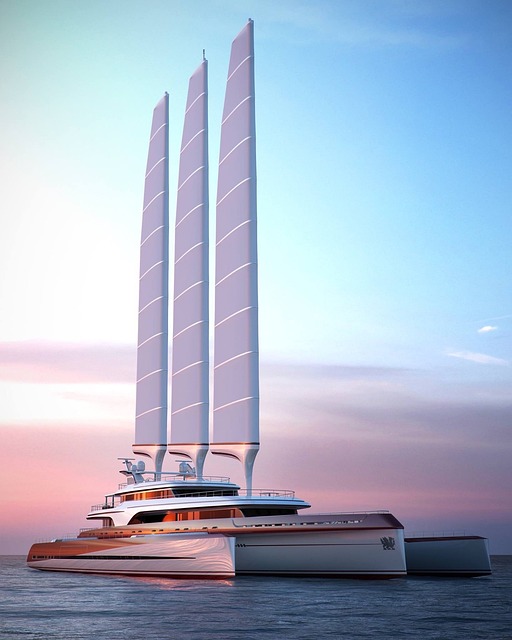Marine batteries are critical for the operation of maritime vessels, providing consistent power for engine starting, electronics, and energy storage. These batteries come in various types, including sturdy lead-acid or advanced AGM options, and require careful selection to match the specific needs of your boat. Proper charging is essential to maintain battery health; this includes regulated amperage and controlled voltage, avoiding overcharging and ensuring long-term performance. Regular maintenance practices such as trickle charging, especially with automatic systems for vessels not in frequent use, are vital to prevent sulfation and extend battery life. Additionally, integrating solar panels can enhance sustainability by offering an alternative charging source, reducing reliance on fossil fuels. In case of a depleted battery, jump-starting using jumper cables from a donor vehicle is a viable solution, but it should be done with caution to avoid damaging the battery or the vessel's electrical system. Routine upkeep, including terminal cleaning and secure connections, helps prevent the need for future jump-starts. Always refer to manufacturer instructions for specific maintenance needs and replacement guidelines to ensure your marine battery operates at its best.
Navigating the intricacies of marine battery systems can be as crucial as understanding the tides for seasoned sailors and novice boaters alike. This article demystifies the various charging types for batteries, ensuring you can maintain your vessel’s power supply with confidence. We delve into the anatomy of marine battery systems, compare different types—from lead-acid to AGM and lithium—and explain charging voltages and amperage essentials. Explore the nuances of trickle charging for long-term maintenance, the benefits of solar panel integration, and learn effective strategies for jump-starting your marine battery without future reliance on such measures. With this knowledge, you’ll be well-equipped to handle all your marine battery needs.
- The Anatomy of Marine Battery Systems: A Comprehensive Overview
- Types of Marine Batteries: Lead-Acid vs. AGM vs. Lithium
- Understanding Charging Voltages and Amperage for Marine Batteries
- Trickle Charging Explained: Maintenance for Long-Term Use
- The Role of Solar Panels in Charging Your Marine Battery
- Strategies for Jump-Starting a Marine Battery and Preventing Future Needs
The Anatomy of Marine Battery Systems: A Comprehensive Overview

Marine batteries serve a critical role in maritime applications, providing reliable power for starting engines, operating onboard electronics, and storing energy during navigation. Understanding the anatomy of marine battery systems is essential for their optimal use and maintenance. At the heart of a marine battery system are the cells, which are grouped into units depending on their configuration. These cells are typically constructed with lead plates; the positive plate is made of spongy lead, while the negative plate uses lead dioxide. The electrolyte solution, usually a mixture of sulfuric acid and water, facilitates the chemical reactions that generate electrical energy.
Marine batteries come in various types, including starter, deep-cycle, and dual-purpose batteries. Starter batteries are designed for short, high-current bursts to crank engines. In contrast, deep-cycle batteries are engineered to provide sustained power with deeper discharge levels, making them ideal for trolling, onboard electronics, and as a house bank. Dual-purpose batteries combine characteristics of both starter and deep-cycle types, offering flexibility for various marine applications. Proper selection based on amp-hour (Ah) capacity, reserve capacity (RC), and cranking amps (CA) is crucial for the intended use. Additionally, factors such as temperature range, physical size, and mounting position must be considered to ensure longevity and performance in the demanding marine environment. Regular maintenance practices, including checking electrolyte levels, cleaning terminals, and ensuring secure mounting, are imperative to prolong the life of the battery system and ensure safe operation at sea.
Types of Marine Batteries: Lead-Acid vs. AGM vs. Lithium

When delving into the realm of marine batteries, understanding the differences between lead-acid, Absorbent Glass Mat (AGM), and lithium options is crucial for optimal performance on the water. Lead-acid marine batteries have been the standard for many years, offering a reliable power source at a lower cost. They are heavy due to their lead content and require regular maintenance to keep them functioning properly, including checking fluid levels and charging. These batteries are suitable for applications with moderate to low power demands like trolling or day trips.
Advancing from the traditional lead-acid design, AGM marine batteries present a spill-proof alternative that’s more resilient to shocks and vibrations often encountered in maritime environments. They also hold a higher charge than their lead-acid counterparts and can handle deeper discharge rates without compromising their lifespan. AGM batteries are maintenance-free, as they are completely sealed and contain absorbed electrolyte solutions. This makes them lighter and more adaptable to a variety of marine applications, from offshore fishing expeditions to larger yachts with more significant power requirements.
In contrast, lithium marine batteries represent the cutting edge in battery technology, offering the highest energy density and lightest weight of all types. These batteries provide an impressive power-to-weight ratio, which is particularly advantageous for longer voyages or when carrying heavier loads. Lithium options also have a longer lifespan and can be charged and discharged more frequently without degradation. The initial cost may be higher than traditional lead-acid batteries, but the benefits in terms of performance and longevity make them an excellent investment for serious mariners looking for reliability and efficiency from their marine battery systems.
Understanding Charging Voltages and Amperage for Marine Batteries

When it comes to maintaining and optimizing the performance of a marine battery, understanding the nuances of charging voltages and amperage is crucial for prolonging its lifespan and ensuring reliable operation. Unlike typical automotive batteries, marine batteries are designed to withstand harsher conditions and deliver consistent power for starting engines and providing sustained energy for onboard electronics over extended periods. Charging these batteries requires careful attention to both the voltage and amperage applied during the process due to their lead-acid or AGM (Absorbent Glass Mat) construction.
Typically, a marine battery should be charged at a voltage that is slightly higher than its nominal voltage, which is usually 12 volts for a 12-volt system. Overcharging can occur if the voltage exceeds the manufacturer’s recommended range, leading to overheating and potential damage to the battery. Therefore, charging systems are often set to deliver a constant voltage that safely recharges the battery without causing distortion or overcharging. The amperage, on the other hand, refers to the rate at which current flows into the battery during charging. A higher amperage can speed up the charging process but must be balanced to prevent excessive heat from being generated within the battery, which could shorten its lifespan. For marine batteries, a charger that delivers between 10 to 50 amperes is typically suitable for fast charging, while some deep-cycle marine batteries may require a lower charge rate of around 2 to 10 amperes for optimal charging. It’s essential to consult the battery’s specifications and use a compatible marine battery charger that adheres to these voltage and amperage parameters to ensure the battery is charged effectively and remains operational for all your nautical adventures.
Trickle Charging Explained: Maintenance for Long-Term Use

When it comes to preserving the health and longevity of a marine battery, understanding the charging types is crucial. Among these, trickle charging stands out as a vital maintenance strategy for long-term use. Unlike fast charging methods that can sometimes stress the battery, trickle charging offers a gentle approach to keeping the marine battery fully charged and ready for use. This method involves a low current that slowly charges the battery over an extended period. It’s particularly beneficial for deep cycle batteries, which are commonly used in marine applications due to their ability to repeatedly discharge and recharge without compromising their performance or lifespan.
Proper trickle charging prevents the sulfation buildup that can occur when a battery sits in a discharged state. It ensures that the lead plates within the battery remain covered with a protective layer of sulfate, which is essential for maintaining optimal battery capacity. For those who store their marine batteries for extended periods, or for vessels that are used infrequently, trickle charging systems can be installed to automatically maintain the battery’s charge level. These systems often come with a float voltage setting that is specifically tailored to marine battery chemistries, such as lead-acid or AGM (Absorbent Glass Mat), ensuring they operate at their best and are always ready to power your nautical adventures. Regular maintenance through trickle charging ensures that the marine battery performs reliably, giving you peace of mind whether you’re on the open water or planning for your next outing.
The Role of Solar Panels in Charging Your Marine Battery

When harnessing renewable energy for your marine battery, solar panels emerge as a pivotal solution. These photovoltaic systems convert sunlight directly into electrical energy, which can be stored in your marine battery to power various onboard systems, from navigation equipment to fish finders. The integration of solar panels with your marine battery setup not only reduces reliance on conventional charging methods but also mitigates the environmental impact associated with fossil fuels. The efficiency of this process is contingent upon several factors, including the size and quality of the solar panels, their exposure to sunlight, and the capacity of the marine battery itself. It’s crucial to select a solar panel system that aligns with your vessel’s power requirements and intended usage patterns to ensure optimal performance and longevity for your marine battery. Additionally, the integration process should be executed with care, considering factors such as the electrical compatibility between the solar panels and the marine battery, and the protection mechanisms in place to safeguard against overcharging or deep discharge scenarios. By thoughtfully incorporating solar panels into your marine battery system, you can enhance the sustainability of your boating experience while maintaining the necessary power supply for all your nautical adventures.
Strategies for Jump-Starting a Marine Battery and Preventing Future Needs

When facing a depleted marine battery, jump-starting it is a common solution to restore power to your vessel’s electrical system. To safely and effectively perform this task, ensure that you have the necessary equipment on hand, such as jumper cables and a functioning donor vehicle. Begin by connecting the red clamp of the jumper cables to the positive terminal of the marine battery. Then, connect the other end of the red clamp to the positive terminal of the donor vehicle’s battery. Subsequently, attach one black clamp to the negative terminal of the marine battery and secure the other end to an unpainted metal surface on the marine vessel that is separate from the battery itself. Never connect the black clamp directly to the marine vessel’s electrical system or to the donor vehicle’s battery without the red clamp in place, as this can be dangerous. Once everything is properly connected, start the donor vehicle’s engine and allow it to run for about five to ten minutes. This will provide sufficient charge to the marine battery, which should bring its voltage up to a level where the vessel’s electrical systems can function normally. Afterwards, disconnect the cables in reverse order: first the black clamp from the metal surface and the marine battery, then the red clamp from both the donor vehicle and the marine battery. Always check your marine battery’s charge level with a hydrometer or digital multimeter before disconnecting to ensure it has received enough power.
To prevent the need for future jump-starts, regular maintenance of your marine battery is crucial. This includes cleaning corrosion from terminals, ensuring a secure connection, and keeping the battery compartment ventilated to avoid overheating. Additionally, monitor the battery’s charge level regularly, and consider installing a battery charger or maintainer that can automatically top off the battery when not in use. Regularly inspect the battery for any signs of wear or damage, and replace it every few years or as recommended by the manufacturer to maintain optimal performance. Using the correct type and size of battery for your marine vessel’s specific electrical requirements is also vital to its longevity and reliability. By taking these proactive steps, you can significantly reduce the likelihood of your marine battery becoming uncharged and in need of a jump-start.
marine battery systems are complex and require careful consideration of their charging types and requirements. From lead-acid to AGM and lithium options, each type offers distinct advantages and maintenance needs, particularly in understanding the nuances of charging voltages and amperage. Homeowners and vessel operators should be well-versed in trickle charging for long-term battery health and harness the power of solar panels as a sustainable charging solution. Additionally, knowledge of jump-starting techniques is crucial to avoid future issues. By understanding these aspects, users can ensure their marine batteries perform optimally, enhancing safety and convenience while on the water.
